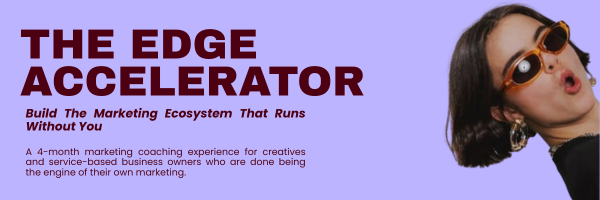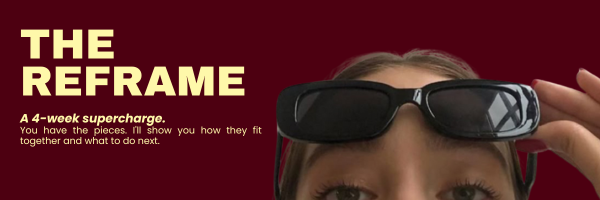Marketing Is Never a One-Off Move (Even If It Looks Like One)
You know that buzz when a post takes off? Comments rolling in, your DMs lighting up, and for a split second you think, finally, something’s working.
Feels good, right?
But here’s the truth: marketing is never a one-off move. That viral post? That email that suddenly got replies? That podcast interview that sent a few dream clients your way?
None of it happened by chance. It happened because of everything you built before it, the trust, the stories, the tone, the consistency.
Marketing isn’t a single play. It’s an ecosystem, a connected rhythm of decisions, systems, and messages that quietly work together behind the scenes.
The Problem With One-Hit Thinking
Most creative and service-based business owners treat marketing like a Tatts ticket: throw out a few posts, cross your fingers, and hope this is the one that finally sticks.
But here’s what really happens when your marketing relies on moments instead of systems:
Every launch feels like you’re starting from scratch.
Every post feels like pushing a boulder uphill.
Every sale feels like luck instead of momentum.
It’s not because your business isn’t working, it’s because your marketing is running in silos, not sync. When your Instagram, website, and email all tell slightly different stories, your audience can feel it, even if they can’t name it.
And when that happens, trust leaks. Momentum fades. Everything starts to feel harder than it should.
The Power Is in the Pattern
Marketing that sticks isn’t loud, it’s layered. It’s not about shouting into the void. It’s about creating small, connected moments that compound over time.
Here’s what that looks like in practice 👇
The Instagram post sparks interest.
You share a behind-the-scenes story or a quick insight that plants a seed.Your website deepens trust.
When someone clicks through, your messaging, visuals, and offers continue the same conversation.Your email makes the offer.
You follow up with context, timing, and relevance, not pressure.The testimonial seals the deal.
Proof. Validation. The “I can see myself in this” moment.
Each move matters, but only because of the ones that came before and after it.
That’s the difference between visibility and velocity. Between showing up randomly… and showing up with rhythm.
How to Build a Marketing Ecosystem (Without Burning Out)
You don’t need to overhaul your entire business to create momentum. You just need to start connecting what you already have.
Here’s how:
1. Pick One Core Message and Thread It Everywhere
If your audience can’t repeat what you stand for, they won’t remember you. Decide what you want to be known for- your edge and make sure it runs through everything: your website headline, social posts, podcast intros, and even your email sign-offs.
Think of it like a chorus that your brand keeps returning to.
👉 Tactic: Audit your last five posts, five emails, and your home page. Do they tell the same story? If not, start connecting the dots.
2. Create a “Bridge Move” Between Every Platform
Every piece of content should have somewhere to go next.
Instagram → Website
Website → Email
Email → Offer
Offer → Testimonial
Testimonial → New Story
This is how you turn one post into a pathway, not a dead end.
👉 Tactic: For every post you plan, ask: What do I want them to do next? Then actually build that bridge (link, CTA, or follow-up email).
3. Build a 3-Part Rhythm: Visibility, Value, and Validation
Your marketing ecosystem should always be feeding these three streams:
Visibility: Gets you seen (social, SEO, PR, collaborations).
Value: Builds trust (emails, blogs, resources, podcasts).
Validation: Proves results (case studies, testimonials, screenshots).
👉 Tactic: When you plan your month, assign 1–2 actions under each category. You’ll instantly start creating balance instead of burnout.
4. Repurpose With Intention (Not Laziness)
Repurposing isn’t copying and pasting, it’s adapting.
That powerful email you wrote? Turn the hook into a post.
That client question you answered? Make it a Reel.
That blog? Break it down into bite-sized carousels.
👉 Tactic: Use a simple Notion or Google Sheet with three columns: “Idea,” “Original Format,” and “Next Format.”
Each time you create something, ask how else it can live.
5. Track Your Compounding Moves
Marketing momentum shows up when your ecosystem compounds.
Look beyond likes, track which actions are quietly working together:
Which blog posts drive email signups?
Which emails get people booking calls?
Which collaborations boost website visits?
👉 Tactic: Once a month, review your analytics (Google Analytics, social insights, email open rates). Highlight any cross-traffic — that’s your ecosystem doing its job.
From Reaction to Rhythm
When you start seeing your marketing as an ecosystem, everything changes:
You stop reacting to algorithms and start leading with intention.
You stop creating content in panic mode and start building structure.
You stop chasing attention and start compounding momentum.
That’s how you move from effort to ecosystem. From running your marketing to letting it finally run for you.
How I Help Clients Build Marketing Ecosystems That Work
This is the work I do inside The Reframe™ and The EDGE Accelerator™, both built to help creatives and service-based business owners stop starting from scratch.
The Reframe™ (4-Week Done-For-You Marketing Strategy)
You’ve built something real, but your marketing feels like a jumble of disconnected ideas. You don’t need another course, you need clarity.
Over four weeks, I audit what exists, map how it connects, and build a clear, actionable marketing strategy.
You implement it. Your marketing finally catches up to your business.
The EDGE Accelerator™ (4-Month Collaborative Ecosystem Build)
When you’re ready to rebuild the foundation, this is where we go deeper.
Across four months and eight sessions, we design your marketing ecosystem from the ground up; positioning, offers, messaging system, marketing hub, and visibility plan. You walk away with a structure that compounds and finally runs without you.
The Wrap-Up: Momentum Beats Luck
That “one post” that blew up? It wasn’t luck. It was the outcome of an ecosystem you’ve been quietly building all along.
Because when your message, systems, and strategy are aligned, your marketing stops being a guessing game. It becomes a rhythm.
And that’s when everything starts to click.
👉 Want to build a marketing ecosystem that runs without you? Start with The Reframe or dive deeper with The EDGE Accelerator.






